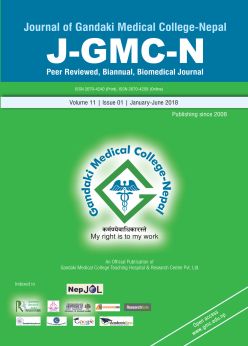Application of Computed Tomography (CT) Attenuation Values in Diagnosis of Transudate and Exudate in Patients with Pleural Effusion
DOI:
https://doi.org/10.3126/jgmcn.v11i02.22957Keywords:
Pleural Effusion, Computed Tomography (CT), Thoracentesis, Exudates and TransudatesAbstract
Background: Pleural effusion is the pathologic accumulation of fluid in the pleural space. The fluid analysis yields important diagnostic information, and in certain cases, fluid analysis alone is enough for diagnosis. Analysis of pleural fluid by thoracentesis with imaging guidance helps to determine the cause of pleural effusion. The purpose of this study was to assess the accuracy of computed tomography (CT) in characterizing pleural fluid based on attenuation values and CT appearance.
Materials and Methods: This prospective study included 100 patients admitted to Gandaki Medical College and Teaching Hospital, Pokhara, Nepal between January 1, 2017 and February 28, 2018. Patients who were diagnosed with pleural effusion and had a chest CT followed by diagnostic thoracentesis within 48 hours were included in the study. Effusions were classified as exudates or transudates using laboratory biochemistry markers on the basis of Light’s criteria. The mean attenuation values of the pleural effusions were measured in Hounsfield units in all patients using a region of interest with the greatest quantity of fluid. Each CT scan was also reviewed for the presence of additional pleural features.
Results: According to Light’s criteria, 26 of 100 patients with pleural effusions had transudates, and the remaining patients had exudates. The mean attenuation of the exudates (16.5 ±1.7 HU; 95% CI, range, -33.4 – 44 HU) was significantly higher than the mean attenuation of the transudates (11.6 ±0.57 HU; 95% CI, range, 5 - 16 HU), (P = 0.0001). None of the additional CT features accurately differentiated exudates from transudates (P = 0.70). Fluid loculation was found in 35.13% of exudates and in 19.23% of transudates. Pleural thickening was found in 29.7% of exudates and in 15.3% of transudates. Pleural nodule was found in 10.8% of exudates which all were related to the malignancy.
Conclusion: CT attenuation values may be useful in differentiating exudates from transudates. Exudates had significantly higher Hounsfield units in CT scan. Additional signs, such as fluid loculation, pleural thickness, and pleural nodules were more commonly found in patients with exudative effusions and could be considered and may provide further information for the differentiation.
Downloads
Downloads
Published
How to Cite
Issue
Section
License
This license allows reusers to distribute, remix, adapt, and build upon the material in any medium or format for noncommercial purposes only, and only so long as attribution is given to the creator.




